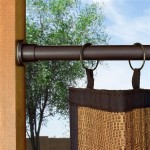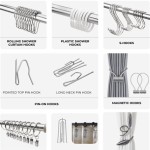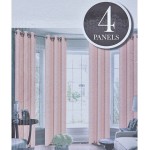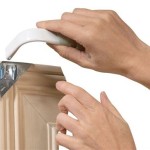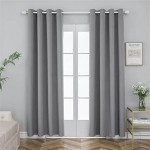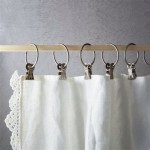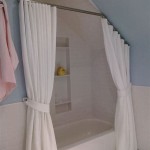80 Inch Curtain Rod Without Center Support: A Comprehensive Guide
The selection of curtain rods is a critical component of window treatment design and functionality. While center supports offer enhanced stability for longer rods, their presence can sometimes detract from the desired aesthetic or create installation challenges. An 80-inch curtain rod without a center support presents a particular set of considerations regarding material, installation, and curtain weight. This article provides a detailed exploration of these factors, outlining the principles necessary for successfully installing and maintaining such a rod.
The primary advantage of using an 80-inch curtain rod without a center support is the uninterrupted sleek line it offers. This is particularly appealing in minimalist or contemporary design schemes. A single, unbroken span allows curtains to traverse the entire width of the window without obstruction, creating a smoother, more visually appealing drape. Removing the center support also simplifies the curtain installation and removal process, allowing for easier maintenance and seasonal changes.
However, the absence of a center support inherently introduces structural challenges. The rod must be sufficiently strong to bear the weight of the curtains across its entire length without sagging or bending. The selection of appropriate materials and installation techniques is therefore paramount to ensure the longevity and functionality of the setup. Failure to adequately address these considerations can result in a compromised aesthetic, functional issues, and potential damage to both the rod and the surrounding wall.
Material Selection and Load Capacity
The choice of material is arguably the most crucial factor determining the success of an 80-inch curtain rod without center support. The material directly dictates the rod's load-bearing capacity, its resistance to bending or sagging, and its overall durability. Several materials are commonly used for curtain rods, each possessing distinct advantages and disadvantages.
Steel is a popular choice due to its high strength-to-weight ratio. Steel rods can typically support heavier curtains without noticeable bending. However, steel is susceptible to rust, particularly in humid environments. Therefore, a powder-coated or otherwise treated steel rod is recommended to prevent corrosion and extend its lifespan. Thicker gauge steel will offer superior support compared to thinner options.
Wrought iron offers a robust and aesthetically pleasing option. Wrought iron rods are known for their durability and ability to support substantial weight. The material's inherent strength allows it to span 80 inches without significant sagging, even with heavier curtains. The texture and appearance of wrought iron also lend a touch of elegance and rustic charm to the space. However, wrought iron can be quite heavy, which necessitates secure mounting hardware and potentially reinforced wall anchors.
Brass is another material frequently used for curtain rods. Brass offers a good balance of strength and aesthetic appeal. It is resistant to corrosion and provides an elegant finish. While brass is generally strong, it may not be as robust as steel or wrought iron. Therefore, it's crucial to select a sufficiently thick brass rod to prevent bending under the weight of the curtains. Alloys with higher copper content tend to offer the best structural integrity.
Wood, while aesthetically appealing, is generally less suitable for 80-inch spans without center support, particularly for heavier curtains. Wood is more prone to bending and sagging over time, particularly if it's not a dense hardwood or if the rod is not adequately thick. While hardwood options like oak or maple can provide greater support, they still require careful consideration of the curtain weight and the overall design.
Aluminum is a lightweight and corrosion-resistant option, but it lacks the inherent strength of steel or wrought iron. Aluminum is best suited for very lightweight curtains and should be chosen with caution for longer spans without center support. Its primary advantage lies in its resistance to rust and its affordability.
Regardless of the material selected, it's critical to verify the rod's load capacity. Manufacturers typically specify the maximum weight the rod can support without bending or failing. This information should be carefully reviewed and compared to the weight of the intended curtains to ensure the rod is adequately sized for the application. Overloading the rod will inevitably lead to sagging, bending, and potential failure.
Installation Techniques and Wall Mounting
Proper installation is equally important as material selection for the longevity and stability of an 80-inch curtain rod without a center support. The method of mounting the rod to the wall directly impacts its ability to bear the weight of the curtains and resist bending forces. Incorrect installation can lead to the rod pulling away from the wall, causing damage to both the rod and the surrounding drywall or plaster.
Locating wall studs is the most secure method for mounting the rod. Wall studs provide a solid anchor point that can withstand significant weight and pressure. A stud finder should be used to accurately locate the studs behind the drywall. The mounting brackets should then be securely screwed directly into the studs using appropriately sized screws. Longer screws offer greater holding power and are recommended for heavier curtains.
If wall studs are not accessible in the desired location, high-quality wall anchors must be used. Several types of wall anchors are available, each with varying load capacities. Toggle bolts are among the strongest options and are suitable for supporting heavier curtains. These anchors consist of a bolt and a butterfly-shaped toggle that spreads out behind the drywall, providing a large bearing surface to distribute the weight. Metal mollies are another robust option that expands behind the wall when tightened, offering secure anchoring. Plastic anchors are generally less strong and should only be used for very lightweight curtains.
Regardless of the type of wall anchor used, it's crucial to follow the manufacturer's instructions carefully. Drilling the correct size hole and properly installing the anchor are essential for achieving the rated load capacity. Over-tightening the screws can damage the anchor or the drywall, while under-tightening can lead to the anchor pulling out of the wall.
The placement of the mounting brackets also plays a role in the stability of the rod. The brackets should be positioned as far apart as possible to distribute the weight evenly across the rod. Ideally, the brackets should be located near the ends of the 80-inch span to minimize bending at the center. Ensuring the brackets are level is also crucial for maintaining a visually appealing and balanced drape. A level should be used to verify that the brackets are aligned before tightening the screws.
For particularly heavy curtains or problematic wall conditions, it may be necessary to reinforce the wall to provide additional support. This can be achieved by adding a wooden backer board behind the drywall. The backer board should be securely attached to the studs and provide a solid surface for mounting the curtain rod brackets. This distributes the weight over a larger area and reduces the stress on the drywall. Another option is to install a header board above the window frame, providing a robust anchor point for the curtain rod brackets.
Curtain Weight and Fabric Considerations
The weight of the curtains themselves is a critical consideration that directly impacts the choice of curtain rod material and installation method. Heavier fabrics, such as velvet, blackout linings, or thick brocades, exert a greater load on the rod, increasing the risk of sagging or bending. Lighter fabrics, such as sheers or lightweight cotton, require less support and are more suitable for rods made of less robust materials.
Before selecting a curtain rod, the total weight of the curtains should be accurately calculated. This can be done by weighing the fabric per yard and multiplying by the number of yards required for the curtains. The weight should then be compared to the load capacity of the chosen curtain rod to ensure it is adequately sized for the application. It is generally advisable to choose a rod with a load capacity that exceeds the actual weight of the curtains by a comfortable margin to account for potential variations in fabric weight or unexpected stress on the rod.
The type of pleating or heading used on the curtains can also affect the weight distribution and stress on the rod. Pinch pleats, for example, tend to concentrate the weight at the top of the curtains, increasing the load on the rod. Grommet tops, on the other hand, distribute the weight more evenly, reducing the stress on the rod. Therefore, the choice of heading should be considered in conjunction with the fabric weight and the rod's load capacity.
For particularly heavy curtains, consider using multiple panels instead of a single, large panel. This distributes the weight more evenly across the rod and reduces the stress on any single point. Also, consider using tiebacks to hold the curtains open during the day. This reduces the amount of time the curtains are fully extended on the rod, lessening the strain and preventing sagging over time. Regular maintenance, such as dusting the curtains and ensuring the mounting hardware is securely fastened, can also help prolong the life of the curtain rod and prevent potential issues.

Roomdividersnow 80 In 120 Premium Tension Curtain Rod White Trod Wh120 The Home

Roomdividersnow 80 In 120 Premium Tension Curtain Rod White Trod Wh120 The Home

Return Rod French Curtain Paso Robles Ironworks

Roomdividersnow 80 In 120 Premium Tension Curtain Rod Black Trod Br144 The Home

Return Rod French Curtain Paso Robles Ironworks

Invisible Single Traverse Rod Curtain Rods Claire Deco

Roomdividersnow 80 In 120 Premium Tension Curtain Rod Silver Trod Slvr144 The Home

Standard Iron Curtain Rod Paso Robles Ironworks

Handmade Ash Curtain Holder Wooden Bracket Modern Minimalist Pole Etsy

How To Hide A Curtain Rod Center Support Bracket

